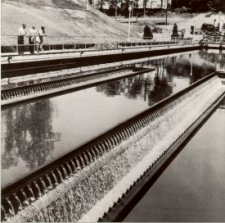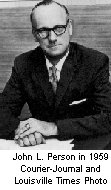The year of MSD’s first rate increase was in many ways a turning point in the history of Louisville and Jefferson County. City and county schools were desegregated peacefully in 1956, and the community won national recognition for its efforts. Work on the first section of the Ohio River floodwall was completed, protecting the city and the Rubbertown industrial complex. The Kentucky State Fair and Exposition Center opened. And voters rejected the first attempt to form a metropolitan government.
In the years since World War II, nearly two dozen suburban cities had been incorporated in Jefferson County. There were two main motivations, mixed in different proportions in different cities: to avoid annexation by Louisville (accompanied by Louisville’s taxes) and to provide at least a few city-type services for the suburbs.
The metropolitan government proposal, drafted by a committee headed by local business executive John Mallon, was an attempt to consolidate local government throughout Jefferson County. It was hotly debated throughout the year. In November, 1956, suburban voters defeated it by more than two-to-one — much more than enough to override Louisville voters’ smaller margin of approval.
MSD was one of the components, if not a major participant, in the battle. Supporters said the plan could provide countywide sewer and drainage services. The defeat of the urban government plan would make the task of providing these services much more complicated over the coming decades.

Courier-Journal and Louisville Times Photo
The struggle to keep up
In early 1959, shortly after the treatment plant went into operation, the Courier-Journal took a comprehensive look at MSD’s accomplishments — along with the growing list of tasks to be done.
In its first dozen years, MSD had built 195 miles of new sewers, at a cost of $33 million. Most of the tasks detailed in the ten-year plan of 1948 had been accomplished, but at far more than the original estimate of $20 million. And MSD still faced tasks that would cost an estimated $41 million — more than the total needs estimated just before the agency was created.
Morris Forman, MSD’s chief engineer, blamed three factors: inflation, inaccurate original estimates of some costs, and extensive additions to the program — including providing sewers to newly annexed areas of the city.
The multiplying tasks were becoming much more difficult to handle. For its first dozen years, the MSD Board had made most of the detailed administrative decisions itself, relying on a full-time secretary-treasurer and a full-time chief engineer to carry them out. As early as 1956, the Courier-Journal had called for a "full-time executive or administrator who can frame and carry out a long-range program of services and who knows how to deal with political and public bodies."
The solution came in February, 1959, when the Board hired Brig. Gen. John L. Person, recently retired from the U.S. Army Corps of Engineers, as "executive consultant." Person, who had overseen a part of the construction of the floodwall as head of the Corps’ Louisville District, would guide the sewer district through some of its toughest political and financial challenges.
John L. Person: MSD's First Top Executive

John L. Person, MSD’s first top executive, joined the agency in 1959 after a 30-year career in the U.S. Army Corps of Engineers. No stranger to Louisville, he had served here twice. His first assignment after graduation from West Point was as assistant to the district engineer in 1929 to1930, when he worked on the construction of Lock 41 at what is now McAlpine Dam. From 1948 to 1950 he was district engineer, in charge of construction of the Ohio River floodwall system.
In 1958, while serving in a high-level engineering post with the corps in Washington, D.C., Person suffered a heart attack. He retired as a brigadier general at age 51, looked around for a new career, and found one in Louisville.
His official title with MSD was "executive consultant." As such, he was not an employee, but a full-time consultant hired to run the agency for the MSD Board.
In February, 1964, as he began his sixth year with MSD, he jokingly told Louisville Times reporter Jack Ayer that he needed to learn only two secrets to solve Louisville’s sewer problems: how to build sewers without money — and how to build sewers without digging holes.
In June, 1965, Person resigned to become executive vice president of the National Rivers and Harbors Congress in Washington, D.C. The Louisville Times called his departure a community loss, saying:
"In the six years he has been with MSD, this gentlemanly retired army engineer has displayed a remarkable ability for getting things done and an enviable talent for public contacts. He has done much to advance this metropolitan area’s sewer and drainage program, and at the same time made many friends in a tough job that doesn’t in the normal course invite popularity."
MSD History continued - A Puzzle of Puzzles


